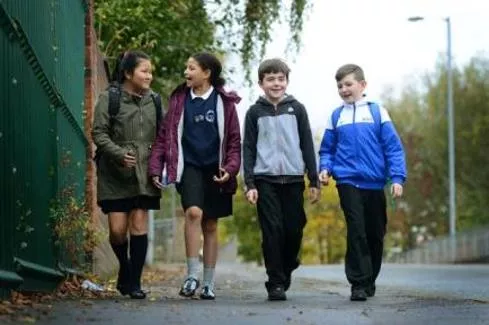Safety and Responsibility: Transitioning to Secondary School
As students transition to secondary school, they are granted more freedom which comes with added responsibility. This period brings significant changes, including traveling to school independently, using public transport, walking, or cycling. However, there are risks involved, with statistics showing increased road collision dangers for 11-year-olds compared to younger children. Ensuring safe travel to school is crucial, with a focus on awareness and precaution.
Download Presentation

Please find below an Image/Link to download the presentation.
The content on the website is provided AS IS for your information and personal use only. It may not be sold, licensed, or shared on other websites without obtaining consent from the author. Download presentation by click this link. If you encounter any issues during the download, it is possible that the publisher has removed the file from their server.
E N D
Presentation Transcript
http://www.sustrans.org.uk/sites/default/files/styles/listing_box_thumb/public/main-image/led_bike_ride_in_north_edinburgh_2.jpg?itok=IpO_r3l5http://www.sustrans.org.uk/sites/default/files/styles/listing_box_thumb/public/main-image/led_bike_ride_in_north_edinburgh_2.jpg?itok=IpO_r3l5 http://i3.manchestereveningnews.co.uk/incoming/article10409096.ece/ALTERNATES/s615/walkingtoschool2.jpg YEAR 6 TRANSITION YEAR 6 TRANSITION INDEPENDENT TRAVEL TO SECONDARY SCHOOL
As you get older you are likely to be given more and more freedom. Having more freedom may seem great but it also means you have to take on more responsibility.
Blazers for secondary school students supplied by School Trends
For a lot of you getting to your new school will bring a big change.
Travel further Use Public Transport Walk alone Cycle alone
An 11-year-old starting secondary school is almost twice as likely as a 10-year-old at primary school to be killed or seriously injured in road collisions (more boys). Statistics from the Department of Transport
Just from Wokingham Boroughs Secondary Schools 9,000 pupils travel to school each day
The percentage of casualties involving 10-14 year olds just on a journey to or from school
Think about getting to school...
walking obesity What is the normal travelling speed of a person walking? 3 mph
What is the travelling speed of a person cycling? 8 - 10 mph
What is the travelling speed of a car? 5 80+ mph
As pedestrians we need to know two facts: 1. The faster a vehicle is going the harder it will hit you
As pedestrians we need to know two facts: 2. The faster a vehicle is going the more time
What is stopping distance? Stopping distance is the distance a vehicle travels from the time the driver decides to stop until it comes to a halt.
Imagine a child runs out in front of a car what sequence of events has to happen before the car stops? Thinking and braking
Signal to Eyes Eyes to Brain Thinking and reacting does not happen instantly Brain to Foot Foot to Brake pedal
Imagine a vehicle travelling at 20 MPH. How far in metres will it take to stop? 12
Imagine a vehicle travelling at 30 MPH. How far in metres will it take to stop? 23
If you were hit by a vehicle travelling at 30mph you have an 80% chance of surviving. If you were hit by a vehicle travelling at 40mph you have an 80% chance of dying.
So remember whether you are walking or riding your bike, vehicles (including bicycles) can not stop instantly.
Journey Planning how are you going to travel? Print map walking and cycle routes on My Journey website and journey planner to plan route from home Bikeability training? Practise route in summer holidays with parents/friends and unaccompanied Always use safe crossings where available zebra crossings, puffin and toucan traffic light crossings for pedestrians, subways, footbridges, islands in the middle of the road, police officers can help too behind bus, between parked cars, brow of a hill, junctions, sharp corners even safe crossings can be dangerous (red light running and driver distractions) What if friends want to take short cut across busy road with no pedestrian crossings? live bus map on My Journey website allow enough time to walk to stop
What can you do to prevent becoming a road traffic casualty statistic? Plan ahead and correctly use proper crossing places
In built up areas 1 out of 5 pedestrian casualties are injured on or near to a crossing
In a year almost 2,150 children aged 1216 are hurt in road incidents because they did not look properly before crossing the road. 55% of casualties happen on the school run!
Talking and messing about with friends, texting, messaging, chatting, playing games on a phone and listening to music are all distractions that make pedestrians less safe.
All you have to do is ... and plan ahead.


























